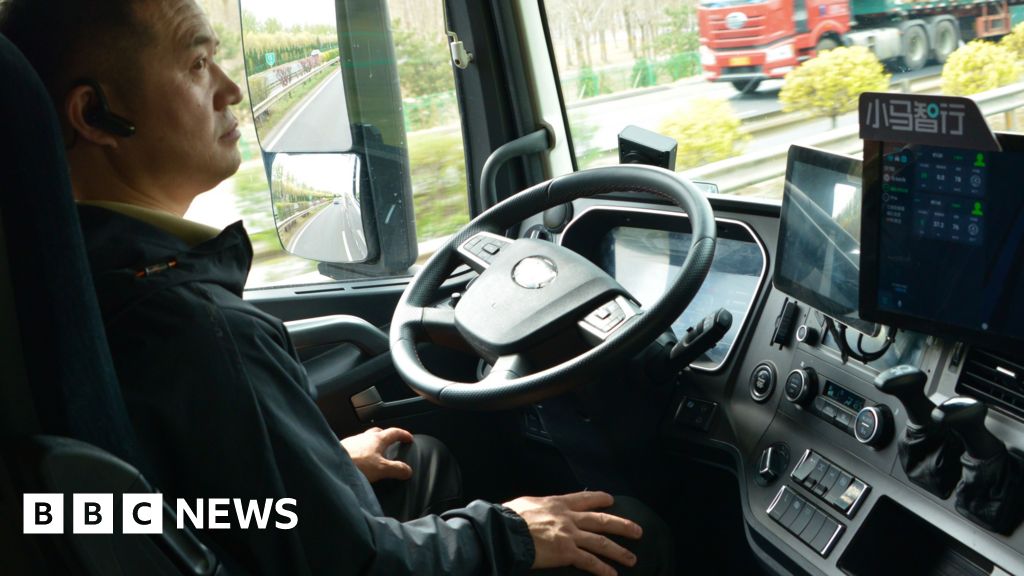China Advances Expansion of Driverless Lorry Technology

China is witnessing a significant push towards transforming its transport industry with the advent of driverless lorries. These autonomous heavy vehicles are already being tested on public highways, such as the route between Beijing and Tianjin port, signaling a potential revolution in logistics and freight movement. While currently operating with safety drivers mandated by regulations, the technology underpinning these lorries suggests a future where human intervention may become minimal.
A firsthand experience on one such driverless truck reveals a mix of awe and apprehension as the massive vehicle navigates itself at speed. Safety driver Huo Kangtian, 32, initially controlled the lorry before engaging its autonomous mode. He described his initial fear but now views the machines as "pretty good and safe," highlighting that autonomous mode can alleviate stress and fatigue, making his job more interesting rather than boring. His role transitions to being the "last line of defence," ready to intervene in emergencies.
Companies like Pony AI are at the forefront of this development. Li Hengyu, the company's vice-president, envisions a future where driverless operations significantly enhance transportation efficiency. Key benefits include reduced labor costs and an improved capacity to handle challenging driving conditions, such as harsh environments and long operating hours, which are often taxing for human drivers.
The primary motivation behind this technological push is economic, according to industry expert Professor Yang Ruigang from Shanghai Jiaotong University. He emphasizes that any technology capable of reducing operating costs is attractive to businesses, making the investment in fully autonomous, driverless trucks justifiable. The ultimate goal, he states, is to "reduce the driver cost close to zero."
Despite the technological advancements, significant hurdles remain before driverless lorries achieve widespread adoption. Public concern is a major factor, especially in China where a fatal accident involving a passenger car in "auto pilot" mode caused a major setback for self-driving technology. Economist Intelligence Unit analyst Chim Lee notes that the Chinese public still requires considerable persuasion before fully embracing driverless vehicles, particularly trucks.
Lee further elaborates that the public image of driverless trucks will be "absolutely critical for policy makers, and for the market as well." Even if their initial use is confined to specific locations, public perception, shaped by safety records and media narratives, will heavily influence regulatory decisions and market acceptance, potentially more so than for passenger vehicles.
Professor Yang Ruigang believes that large-scale job losses for lorry drivers are not imminent, particularly for operations in open environments or at high speeds. However, he points out that low-speed applications, such as last-mile delivery trucks, are already a reality in certain contexts.
A prime example of current implementation can be found in Hefei, a city in Eastern China's Anhui Province. Here, hundreds of driverless delivery vans, like those operated by Rino.ai, navigate suburban streets alongside human-driven traffic. These vans address a market niche by transporting parcels from large distribution hubs to local neighborhood stations, after which scooter drivers complete the final delivery to customers' doorsteps.
Gary Huang, president of Rino.ai, explains that this system allows couriers to focus on community-level pickup and drop-off, while autonomous vans handle the more repetitive, longer-distance segments, thereby boosting overall system efficiency. Rino.ai is also expanding internationally, with plans to deploy its driverless delivery vehicles in Australia with a supermarket chain later this year. In China, the company states it operates over 500 vans in more than 50 cities, with Hefei being the most advanced in terms of regulatory support and implementation.
Hefei's progressive stance is attributed by Huang to a combination of government encouragement, local experimentation, experience gathering, and regulatory refinement, leading to broader implementation. These autonomous vans are now a common sight on Hefei's roads, adeptly changing lanes, signaling turns, and adhering to traffic signals while avoiding other traffic.
For courier companies, the economic benefits are compelling. According to Zhang Qichen, Rino's regional director for Anhui Province, three autonomous electric delivery vans, which can operate for days without needing a charge, can be run for the same cost as employing one human driver. She also noted that these vans contribute to faster deliveries and expressed astonishment at the rapid pace of change within her industry.
Looking ahead, both industry insiders and experts are optimistic about the future of heavy, long-haul driverless lorries. Zhang Qichen anticipates that such lorries could be routinely self-driving on roads in certain circumstances within five years. Professor Yang concurs, suggesting that heavy trucks running unrestricted on highways are "at least five years away," and he expresses strong confidence that this will happen.
Industry insiders suggest that the most immediate applications for driverless lorries, apart from enclosed industrial zones like open-cut mines or ports, are likely in remote, harsh terrain with extreme environmental conditions, especially along vast stretches and in largely straight trajectories. However, significant technical challenges persist. Heavy lorries need better cameras to track well ahead to detect hazards much further down the road, comparable to human vision. More tricky road sections may also need to have extra sensors placed along the route.
Other hurdles include managing breakdowns in extreme weather or sudden, unexpected dangers emerging amidst very busy traffic. On top of all this, the technology for heavy driverless lorries is still not cheap. What's more, these vehicles are currently often modified old-style lorries rather than self-driving vehicles designed and built as autonomous from the outset.
China is keen to be a champion of new technology but also has to proceed carefully. This caution is necessary not only because of the potential for deadly accidents but also due to how the Chinese people might view this significant shift. As Chim Lee points out, it's not just about fulfilling regulations or building a public image. The goal is that, over time, "the public will see the benefit of this technology, see how it will reduce their costs for buying things, or look at it as a way of imagining that society is improving, rather than viewing this as technology which is potentially destroying, causing car accidents or removing employment opportunities."
Professor Yang sees another critical problem related to public acceptance. "We humans can tolerate another human driver making mistakes but our tolerance for autonomous trucks is much much lower," he observes. "Machines are not supposed to make mistakes. So, we have to make sure that the system is extremely reliable." This highlights the paramount importance of achieving exceptionally high levels of reliability and safety for autonomous driving systems.











